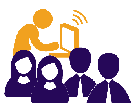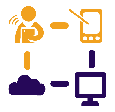Data for Health Initiative
CDC is collaborating with Bloomberg Philanthropies, CDC Foundation, and other partners to collect better public health data in low- to middle-income countries across Latin America, Asia, and Africa.
Training Course on Civil Registration and Vital Statistics (CRVS) Systems
Designed for public health professionals, this course provides information about characteristics, functions, uses, assessment, and improvement of CRVS systems.
The Bloomberg Data for Health initiative strengthens the collection and use of critical public health information. As part of its newest phase, Data for Health has expanded its partnership to more than 40 countries’ governments to:
- Strengthen the quality of birth and death registration and information on causes of death
- Explore innovative approaches to non-communicable disease surveys and surveillance
- Enhance use of data for maximum impact in policymaking and priority setting
- Support cancer registries to track diagnosis, treatment, and outcomes at the country level
- Implement smaller scale time-bound projects that improve public health data in the D4H thematic areas through the Global Grants Program
Data for Health approaches its goal in 3 ways as a roadmap to improving global health: systems, innovation, and communication. There is an emphasis on using data to identify opportunities, ensure accountability, and maximize the impact of limited resources. When combined, this improves capacity in Ministries of Health to use health data to inform public health policy development and help nearly 5 billion people across the globe live healthier, longer lives.

The challenge: Lack of usable data and data collection systems
Civil Registration and Vital Statistics (CRVS) information systems collect information on number of births and deaths, as well as cause of death. According to the World Health Organization (WHO), many countries do not have adequate systems in place to collect this data, resulting in millions of births and more than 38 million deaths going unreported each year.[i]
What this means: Health professionals and governments use data in deciding how to address the needs of communities. Information on births is needed to determine how many people are in need of resources. Cause of death information helps public health experts decide which programs can save the most lives. Without accurate data, it is difficult to know what solutions could help communities.
How the initiative helps: The Initiative supports countries in strengthening their CRVS systems. Assistance will be available to assess CRVS systems and develop improvement plans, improve cause of death assignment using internationally recognized standards, improve registration practices, and produce high quality data.
CDC contribution: CDC’s National Center for Health Statistics provides technical expertise and helps develop a workable system to capture accurate information on births and deaths. With its partners, CDC improves health data registration systems, which improve the quantity and quality of this data to inform policy-making.

The challenge: Finding alternative methods to collect data.
In many countries, health workers collect health data using in-person surveys. While this is a useful way to collect some data, it can be time consuming and costly. Decreasing the time it takes to collect, analyze, and communicate data can help improve the allocation of resources and decrease preventable deaths, especially in areas most in need of healthcare services.[ii]
What this means: Efficient monitoring and surveillance are cornerstones to track progress. Systematic monitoring of risk factors and vital records is essential. With accurate data and analysis, countries will be able to prioritize essential resources and make sound policy decisions.
How the initiative helps: With increasing use of mobile phone access globally, opportunities exist to explore the feasibility of using this technology as an interim method to collect data and complement household surveys. Such technologies have the potential to allow for efficiencies in producing timely, affordable, and accurate data to monitor trends, and supplement traditional health surveys with new, faster mobile phone surveys.
CDC contribution: CDC’s Global Noncommunicable Disease Program will work throughout the agency and alongside partners to implement multiple mobile phone surveys in twelve countries and test whether using mobile phones to collect health data is useful. The project will assess the feasibility, quality, and validity of using mobile phone surveys to determine whether it can meet the standards of face-to-face collection methodology.

The challenge: Not enough data is being turned into action.
Many low- and middle-income countries struggle to use public health data to inform policy decisions. This is partially because of a shortage of epidemiologists with specialized health policy writing and communication skills, and lack of a forum in which to share scientific findings.
What this means: Policy makers do not have the public health information needed to make decisions based on the most pressing issues threatening the public’s health. Community health needs continue to be unmet, and preventable deaths continue.
How the initiative helps: The Initiative collaborates with governments on using data to prioritize health issues, develop policies and programs, monitor impact, and communicate with stakeholders. Technical assistance supports skill development needed to analyze data for policy development; use information technology to compile, manage, and share data from multiple sources; and present and disseminate data to stakeholders.
CDC contribution: CDC’s National Public Health Institute (NPHI) Program helps strengthen countries’ data communication platforms, which are used to share public health information with policymakers and the public through training in epidemiology and economic evaluation to support policy brief development. CDC has a Data to Policy curriculum implemented through Field Epidemiology Training Programs (FETP), NPHIs, and other Ministry of Health partners, and provides specialized in-country training using epidemiology case studies and other effective learning modules. Support is also provided to develop Public Health Bulletins, which serve as the voice of government, alerting professionals and public-to-public health threats, providing updates on the control of disease and other health conditions, as well as providing recommendations and other guidance. In addition, scientific communications training for FETP residents and graduates results in submission and publication of articles in national and international scientific journals.